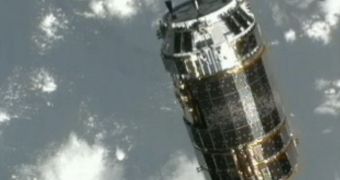After spending six days chasing the International Space Station (ISS) in low-Earth orbit, the Japan Aerospace Exploration Agency (JAXA) H-II Transfer Vehicle (HTV-3) was finally grappled via the outpost's robotic arm, earlier today.
The unmanned cargo spacecraft does not feature an automated docking system. Therefore, mission controllers set it on a course that took it within 12 meters (40 feet) of the orbital lab. From this distance, it was grappled by Expedition 32 astronauts, using the Canadian-built Canadarm-2 robotic arm.
HTV-3 was “fished” from space at 8:23 am EDT (1223 GMT). In charge of handling the 18-meter (58-foot) Canadarm-2 were NASA astronaut Joseph M. Acaba and JAXA astronaut Akihiko Hoshide.
After grappling it, the duo moved the spacecraft, also known as Kounotori 3, to the Earth-facing port on the American-built Harmony module. Docking occurred at around 10:30 am EDT (1430 GMT).
The vehicle delivers food, water, fuel, scientific experiments and personal items for Expedition 32 astronauts, in addition to a series of five CubeSats, to be launched in orbit directly from the ISS this September, Space reports.
The successful grappling maneuver comes just 4 days after the Russian-built Progress 47 space capsule failed to dock to the space station, during a test of its newly upgraded Kurs-NA automatic orbital docking system.
Another attempt to dock the Progress spacecraft will occur on Sunday, July 29. The vehicle, which delivered supplies to the ISS earlier this year, undocked from the orbital outpost for the test on July 21.
HTV-3 launched to space aboard an H-IIB delivery system, from the Yoshinobu-2 launch pad, at the Tanegashima Space Center, in Japan. Takeoff occurred on July 21, but the position of the spaceport meant that the vehicle needed to spend more time in orbit than Russian capsules usually do.
The school bus-sized spacecraft carries 4 tons of cargo. It has a length of 10 meters (33 feet), and is around 4 meters (13 feet) wide. In addition to the aforementioned supplies, it also delivered the ISERV (International Space Station SERVIR Environmental Research and Visualization System) camera.
The hatches separating HTV-3 from the ISS will be opened tomorrow, July 28, Space reports.

 14 DAY TRIAL //
14 DAY TRIAL //